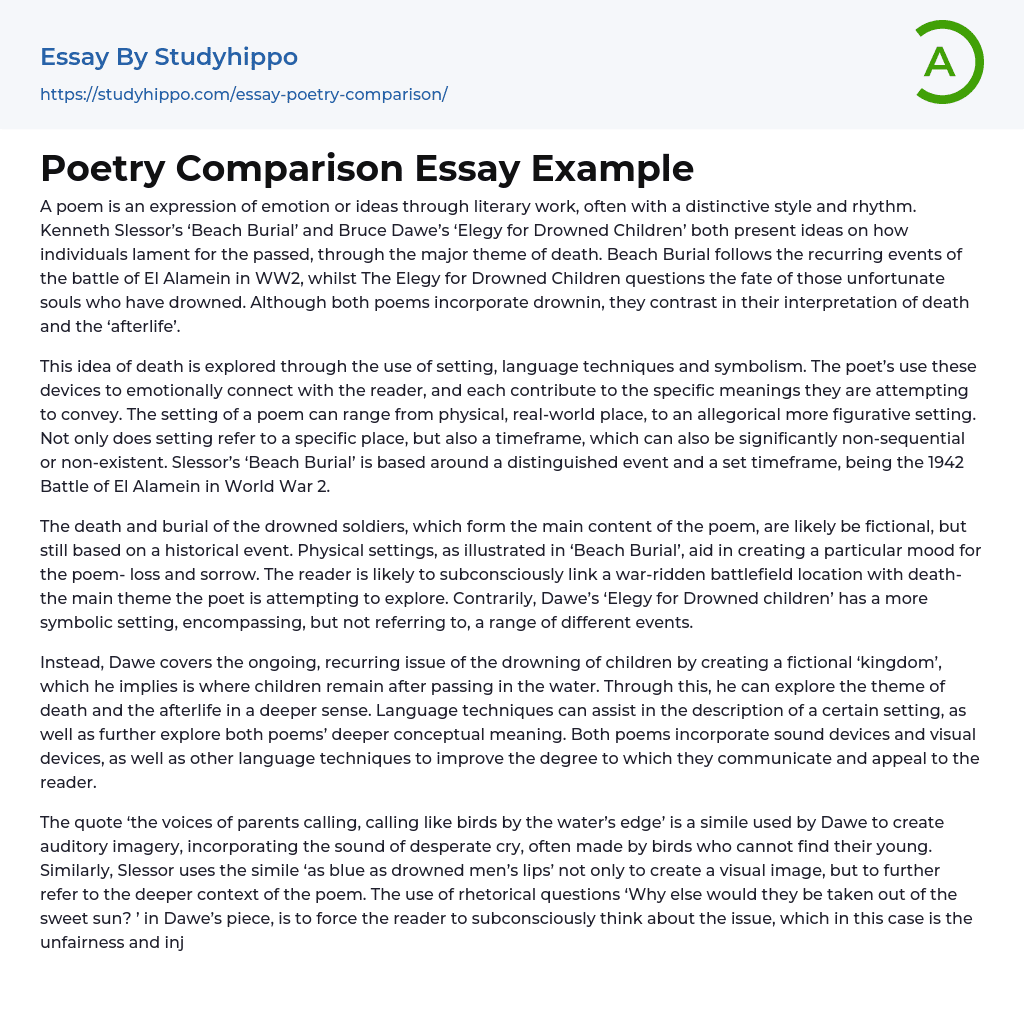A literary work called a poem expresses emotion or ideas with a unique style and rhythm. Kenneth Slessor's 'Beach Burial' and Bruce Dawe's 'Elegy for Drowned Children' both explore death and mourning. While 'Beach Burial' reflects on the Battle of El Alamein in World War II, 'Elegy for Drowned Children' ponders the fate of those who have drowned. Although both poems discuss drowning, they have different views on death and what comes after.
This text explores the concept of death by using setting, language techniques, and symbolism. The poet uses these devices to establish an emotional connection with the reader and convey specific meanings. The poem's setting can be either a physical location or a symbolic one. It encompasses not only a specific place but also the timeframe, which may not follow a sequential order or eve
...n exist at all. Slessor's 'Beach Burial', set during World War 2's 1942 Battle of El Alamein, focuses on a significant event and a particular timeframe.
Both 'Beach Burial' and 'Elegy for Drowned Children' explore the theme of death in distinct ways. The soldiers' death and burial in 'Beach Burial' may be fictional, but it is based on a real event, evoking emotions of sorrow and mourning through its tangible setting. On the other hand, 'Elegy for Drowned Children' uses a metaphorical backdrop to encompass various incidents without directly referencing them.
Instead of directly addressing the recurring issue of children drowning and their tragic deaths, Dawe presents a fictional 'kingdom' where these children are believed to go after passing away in water. This concept allows him to delve into the themes of death and
the afterlife in a more profound way. The use of various language techniques helps to vividly describe the setting and enhance the deeper meaning of both poems. Both poems employ sound devices, visual devices, and other language techniques to effectively communicate with and captivate the reader.
Both Dawe and Slessor use similes to create vivid imagery in their poems. In Dawe's poem, he compares the voices of parents calling to birds by the water's edge, conveying the desperate cries of birds searching for their young. Similarly, Slessor likens something as blue as drowned men's lips to depict a visual image while also hinting at a deeper meaning in his poem. Additionally, Dawe employs rhetorical questions like "Why else would they be taken out of the sweet sun?" to make readers ponder on the subconscious level about life's injustices and unfairness.
Although not using rhetorical questions, Slessor employs structure and sequence to mirror the narrator's emotional state. He accomplishes this by commencing the poem with a mellow tone, employing gentle sounds like 'softly, humbly, sway, wander, and rolls' to deceive the reader into a state of tranquility. As the true theme and subject of the poem—drowning soldiers—is gradually revealed, the sounds in the poem become sharper and more dissonant, expressing the emotional strain induced by burying the deceased.
Both poems share similarities in their rhythmic structures, breaking into five quatrain stanzas of irregular metre and utilizing enjambment. Symbolism is employed by both poets to convey a deeper meaning, particularly related to death. In Beach Burial, Slessor suggests that death brings together opposing forces, as they are "enlisted on the other front." This phrase
symbolizes heaven or the afterlife. Similarly, Dawe's fictional character, known as "the king," is a representation of King Neptune, the Roman God of the Sea.
In this poem, the King takes the children individually to his kingdom, which is believed to be the afterlife for drowned children. King Neptune personifies death itself, with his power and authority over the water. The King's "sure net" symbolizes the unstoppable force of the tragedy and may suggest the poet's belief in destiny. While both poets use a sad tone to explore the theme of death, they also suggest that death can be seen as a welcoming place, a new beginning that brings comfort to those who have lost loved ones.
Dawe and Slessor use setting, language techniques, and symbolism in their poems "Elegy for Drowned Children" and "Beach Burial" to convey meaning. Slessor's experience as a war correspondent during the battle of El Alamein greatly influences his piece. As for Dawe, his various occupations have given him empathy with people from all backgrounds. Despite their distinct writing styles, both poets explore the theme of death and raise questions about the possibility of spiritual continuance after death.
- Book Summary essays
- Metaphor essays
- Reader essays
- Rhyme essays
- Literary devices essays
- Villain essays
- Books essays
- Genre essays
- Literary Criticism essays
- Writer essays
- Protagonist essays
- Simile essays
- Poem essays
- Book Report essays
- Book Review essays
- Greek Mythology essays
- Plot essays
- Tragic Hero essays
- Coming of Age essays
- Play essays
- Rhetoric essays
- Rhetorical Question essays
- Translation essays
- Understanding essays
- Reason essays
- Character essays
- Letter essays
- American Literature essays
- Literature Review essays
- Utopia essays
- Poetry Analysis essays
- Dante's Inferno essays
- Between The World and Me essays
- Incidents in The Life of a Slave Girl essays
- Flowers for Algernon essays
- Myth essays
- Everyday Use essays
- Boo Radley essays
- Genesis essays
- Richard iii essays
- Alice in Wonderland essays
- On the road essays
- Ozymandias essays
- The Nightingale essays
- Holden Caulfield essays
- Animal Farm essays
- 1984 essays
- A Hanging essays
- Shooting An Elephant essays
- A Tale Of Two Cities essays




